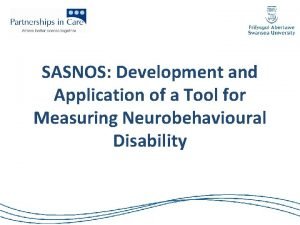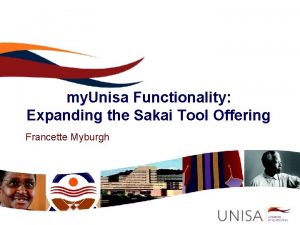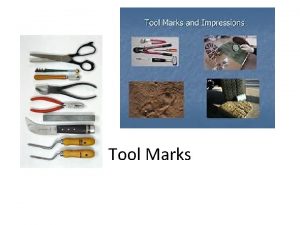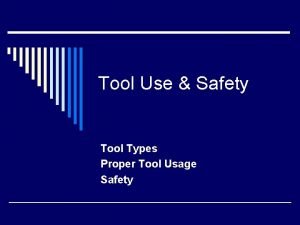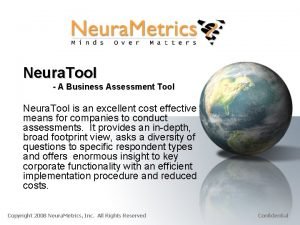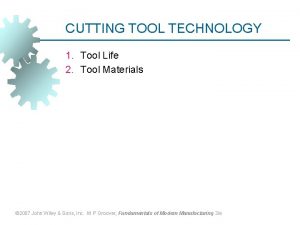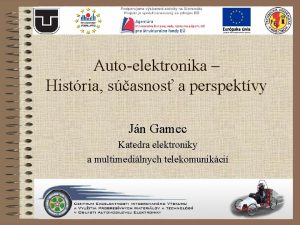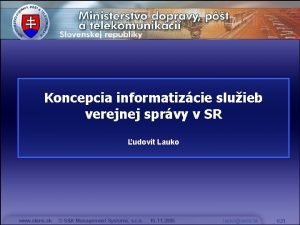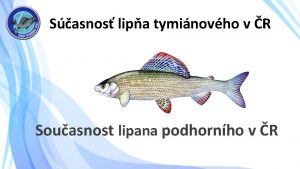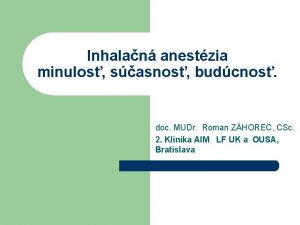SASNOS Development and Application of a Tool for











































- Slides: 43

SASNOS: Development and Application of a Tool for Measuring Neurobehavioural Disability

Who’s Who? Dr Claire Williams Dr Caroline Knight Dr Jenny Brooks Professor Nick Alderman Dr Paula Foscarini-Craggs

Overview • Background and Development of the SASNOS • Practical use of the SASNOS – scoring and interpretation • Responsiveness of the SASNOS • Clinical case studies • Looking ahead: SASNOS-R

Neurobehavioural Disability • Useful framework for helping us to understand what drives challenging behaviour after ABI. • Complex, subtle, pervasive constellation of cognitive-behavioural changes that characterise post-acute ABI (Wood, 2001).

Neurobehavioural Disability • Product of interactions between damaged neural systems and neurocognitive impairment, further modified by premorbid personality traits and learning. – – – Executive and attentional dysfunction Altered emotional expression Poor impulse control Range of personality changes Poor insight Problems of awareness and judgement

Neurobehavioural Disability • Behavioural characteristics associated with NBD are enduring and impose serious long-term social handicap. • NBD = poor prognosis. • Neurorehabilitation has shown that many behavioural problems can be ameliorated to reduce their psychosocial impact.

Given the Potentially Catastrophic Impact of NBD, How Can We Measure It? • • Understand how it develops over time Rehabilitation planning Measuring NBD Track progress has proved to be Recovery/rehabilitation outcomes challenging! Discharge planning Effectiveness of rehabilitation services To inform cost-savings Research

Widely Used Measures of NBD Neurobehavioural Rating Scale (NRS) Neurobehavioural Rating Scale – Revised (NRS-R) Neurobehavioural Functioning Inventory (NFI) Neurobehavioural Functioning Inventory-66 (NFI-66) Neuropsychology Behaviour and Affect Profile (NBAP) • Key Behaviours Change Inventory (KBCI) • Head Injury Behaviour Scale (HIBS) • Ruff Neurobehavioural Inventory (RNBI) • • •

Work is Still Needed Kolitz et al (2003) argued that there was still a need to develop a valid and comprehensive ‘global’ instrument for the measurement of NBD.

Professor Nick Alderman Director of Clinical Services and Consultant Clinical Neuropsychologist at Brain Injury Services, Partnerships in Care. He previously held senior posts at the Brain Injury Rehabilitation Trust and St Andrew’s Hospital, Northampton. He holds a number of honorary and visiting academic appointments, including at Swansea University, University of the West of England, and the University of Birmingham. Principal interests include neurobehavioural rehabilitation, challenging behaviour, dysexecutive syndrome and outcome measurement. Dr Claire Williams Senior Lecturer in the Department of Psychology at Swansea University. She has a strong track record of applied and translational research, leadership experience of delivering research projects with clinical impact, and experience of developing specialist neurobehavioral assessment tools for use in brain injury. Principal research interests include neurobehavioural disability, emotional processing and regulation, dysregulated behaviours, and outcome measurement. Professor Rodger Llewellyn Wood Professor Emeritus of Clinical Neuropsychology at Swansea University and Honorary Consultant Clinical Neuropsychologist at ABM University Health Board. He has worked in brain injury rehabilitation since 1978, at the Kemsley Unit, Northampton, Casa Colina Hospital, California, and the Brain Injury Rehabilitation Trust, UK. His current research focuses on the nature and assessment of neurobehavioural legacies of traumatic brain injury.

Review of Existing Measures of NBD • Undertook review of the psychometric properties of 8 widely used measures of NBD. • Determine a set of recommendations for future measures of NBD. Wood, Alderman & Williams (2008). Assessment of neurobehavioural disability: a review of existing measures and recommendations for a comprehensive assessment tool. Brain Injury, 22, 905– 918

Existing Measures of NBD - Comparison of Psychometric Properties (Wood, Alderman & Williams, 2008)

Review of Existing Measures of NBD • Existing tools contained methodological problems of definition, conceptualisation and measurement of NBD. • Scores difficult to use in a way that is clinically or socially meaningful as an indication of outcome.

How Can NBD be Measured? There is a solution To this puzzle!

St Andrew’s-Swansea Neurobehavioural Outcome Scale (SASNOS) • Designed specifically to capture NBD. • Measurement tool that can be used for clinical work and for research purposes. • Meets many of the recommendations made in our 2008 review paper.


How Can I get It? • Email us: SASNOS@swansea. ac. uk

What Do I Need? • • • SASNOS self vs. other versions Guidance Notes Excel Scoring File (new and old versions) Multiple SASNOS Power. Point Template SASNOS Protocol

But I’m really keen to know even more!

SASNOS Items • 49 items describing symptoms of NBD • Items rated by choosing one of seven verbal descriptors • Balanced keying to reduce likelihood of acquiescence responding (bias) • Scoring constructive – higher ratings reflect perception of ability

Verbal Descriptors (ordinal) Rank Order Descriptor items 16, 2742, 44 -49 Definition 1 7 ‘Never’ no behaviour/symptom observed within the review period 2 6 ‘Rarely’ the behaviour/symptom has been observed once or twice 3 5 ‘Occasionally’ the behaviour/symptom has been observed a few times 4 4 ‘Sometimes’ the behaviour/symptom has been observed on about 50% of occasions when applicable 5 3 ‘Fairly Often’ the behaviour/symptom has been observed on many occasions 6 2 ‘Very Often’ the behaviour/symptom has been evident nearly all the time 7 1 ‘Always’ the behaviour/symptom has been a constant feature of the person throughout the review period


SASNOS Administration and Scoring • In inpatient context, ideally completed by MDT members, as a group, who know the patient well. • Items rated from observations of the patient during the preceding 14 day period. • Ratings entered into Excel file which converts to standardised distribution based on ratings of neurologically healthy controls. – – total sum of ratings 5 principal domains 12 sub domains 3 graphical representations of data

Principal Domains Interpersonal Behaviour 15 Sub Domains Social interaction 5 Relationships 5 Engagements 5 Cognition 12 Executive function 6 Attention & memory 6 Inhibition 6 Sexual 3 Social 3 Aggression 12 Communication 4 Provocative behaviour 5 Irritability 4 Overt aggression 3 Speech & language 2 Mental state 2

How Often Should SASNOS Be Administered? • Neurobehavioural Rehabilitation: – Week 3 of admission – At subsequent CPA, every 3 -6 months – When clinically useful!

A Few of the (many) Strengths of the SASNOS…

A Few of the (many) Strengths of the SASNOS… Simon’s Great! Do different people rating the same patient do so similarly? I Agree With David!

Inter-Rater Reliability • Do different people rating the same patient do so similarly? • Good measures minimise error due to interscorer differences (interpretation, subjectivity), changes are real (outcome) • 50 patients rated independently by pairs of raters • ICC total sum ratings =. 81 ‘outstanding’* (*Landis & Koch, 1977).

Availability of Normative Data • Neurologically healthy control data used to transform ratings into T-Scores (mean 50, sd 10) • Use of standardised distribution enables direct comparison of factor scores and interpretation • Suggests what scores may fall within the ‘normal’ or expected range • Profile of strengths and needs • Benefits to clinical practice

Comparison of psychometric properties between the SASNOS and the existing measures of neurobehavioural disability and social handicap reviewed by Wood, Alderman & Williams (2008) Content Validity Not adapted from non. ABI measure No. item Informant version Content yes 49 yes NRS 1 27 NRS-R 2 Construct Validity Reliability Face Factorial/ data reduction (no. Items) Internal consistency Convergent/ divergent Discriminant/ Diagnostic Validity Interrater Testretest yes 5 yes yes yes 4 yes yes 29 yes 5 yes NFI 3 70 yes 6 yes NFI-664 66 yes 4 yes SASNOS yes NBAP 5 yes 66 yes 5 yes KBCI 6 yes 64 yes 8 yes HIBS 7 yes 20 yes 2 yes RNBI 8 yes 243 3 yes In addition to CTT techniques, Rasch analysis also employed yes

SASNOS TOTAL RATINGS AND PRIMARY FACTORS >2 SD >1 SD T-score Normal Range <1 SD <2 SD <3 SD

SASNOS SECONDARY FACTORS >2 SD T-score >1 SD Normal Range <1 SD <2 SD <3 SD

Communication Inhibition SASNOS Individual Item Ratings Interpersonal Relationships Aggression Cognition

Reporting and Interpretation • Profile of strengths and needs • Potential rehab goals • Progress and outcome • Context!

Strengths Needs Insight & Goals

Progress & Outcome

Visual Representation of Functional, Neurobehavioural and Social Outcome Following ABI Rehabilitation Communication Cognitive Function Self Care Inhibition Psychosocial Adjustment Interpersonal Behaviour Sphincter Control Mobility/ Transfers Communication Aggression Cognition Locomotion Admission Current Goal

Context Ratings Made in #1

Context Ratings Made in #2

Context Ratings Made in #2 b

1 No help or support 2 Requires help and support 3 Requires structured programme/intervention Additional measure to reflect levels of support? • 1 – no help or support • 2 – requires help or support • 3 – requires structured programme/intervention


 σασνος
σασνος Potter's wheel data cleaning tool
Potter's wheel data cleaning tool Unisa application tool
Unisa application tool Web application stress
Web application stress Kontinuitetshantering i praktiken
Kontinuitetshantering i praktiken Typiska drag för en novell
Typiska drag för en novell Tack för att ni lyssnade bild
Tack för att ni lyssnade bild Ekologiskt fotavtryck
Ekologiskt fotavtryck Varför kallas perioden 1918-1939 för mellankrigstiden
Varför kallas perioden 1918-1939 för mellankrigstiden En lathund för arbete med kontinuitetshantering
En lathund för arbete med kontinuitetshantering Särskild löneskatt för pensionskostnader
Särskild löneskatt för pensionskostnader Personlig tidbok för yrkesförare
Personlig tidbok för yrkesförare Anatomi organ reproduksi
Anatomi organ reproduksi Vad är densitet
Vad är densitet Datorkunskap för nybörjare
Datorkunskap för nybörjare Tack för att ni lyssnade bild
Tack för att ni lyssnade bild Hur skriver man en tes
Hur skriver man en tes Delegerande ledarskap
Delegerande ledarskap Nyckelkompetenser för livslångt lärande
Nyckelkompetenser för livslångt lärande Påbyggnader för flakfordon
Påbyggnader för flakfordon Lufttryck formel
Lufttryck formel Offentlig förvaltning
Offentlig förvaltning Jag har gått inunder stjärnor text
Jag har gått inunder stjärnor text Presentera för publik crossboss
Presentera för publik crossboss Jiddisch
Jiddisch Plats för toran ark
Plats för toran ark Treserva lathund
Treserva lathund Mjälthilus
Mjälthilus Claes martinsson
Claes martinsson Cks
Cks Programskede byggprocessen
Programskede byggprocessen Mat för unga idrottare
Mat för unga idrottare Verktyg för automatisering av utbetalningar
Verktyg för automatisering av utbetalningar Rutin för avvikelsehantering
Rutin för avvikelsehantering Smärtskolan kunskap för livet
Smärtskolan kunskap för livet Ministerstyre för och nackdelar
Ministerstyre för och nackdelar Tack för att ni har lyssnat
Tack för att ni har lyssnat Vad är referatmarkeringar
Vad är referatmarkeringar Redogör för vad psykologi är
Redogör för vad psykologi är Matematisk modellering eksempel
Matematisk modellering eksempel Atmosfr
Atmosfr Borra hål för knoppar
Borra hål för knoppar Vilken grundregel finns det för tronföljden i sverige?
Vilken grundregel finns det för tronföljden i sverige? Varians formel
Varians formel
